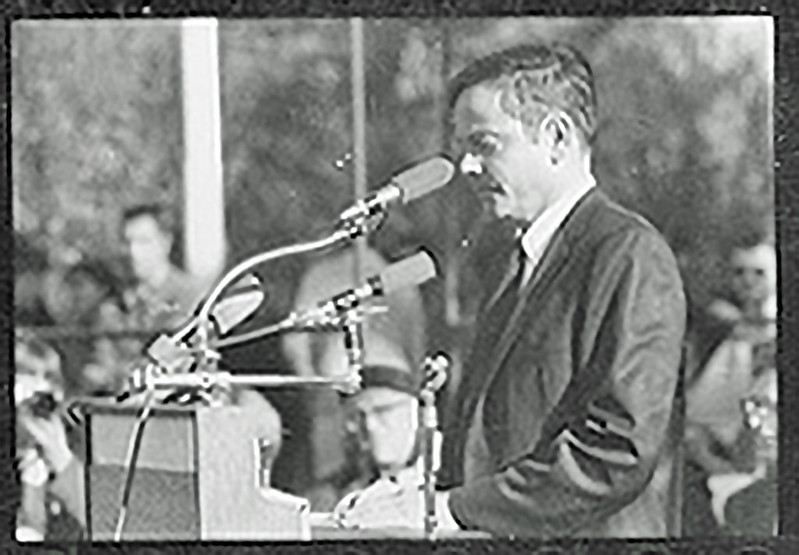Staughton Lynd (1929–2022)
In remembrance

There are moments with people that leave indelible marks on your life. Waking up on the floor of Alice and Staughton Lynd’s home in the early winter of 2001 was one of those moments for me. That morning, Staughton sang an old Wobbly song as Grace before sharing breakfast at their table.
Next to Alice sat autoworker and historian Marty Glaberman, who passed just a few months later. And then, Peter Linebaugh incited us with reflections on Tecumseh and reclaiming the commons. My friend Eric O’Neil from the Laborers union and I had travelled to Youngstown from Cincinnati. We found warmth, brilliant comrades, and an infectious creativity that weekend.
We gathered, along with a few dozen others involved in the massive global justice movement, in an ailing Odd Fellows Hall to begin constructing a new Port Huron Statement. I was admittedly skeptical of re-creating a project that was so particular to a time four decades earlier, with a radically different cast of players. Staughton seemed skeptical as well, but pressed us all on the need to record the emancipatory dreams of a new generation of radicals. And a new Port Huron Statement seemed like a good enough starting point.
Al Haber, the first president of SDS, brought his handmade Peace Table from Michigan. Alexis Buss, then-General Secretary-Treasurer of the IWW was there. Autoworkers from Jeep, former steelworkers, and a host of younger global justice militants rounded out the room.
I don’t think we ever finished the new statement. But the gathering—thanks in large part to Staughton—was exactly the type of ecumenical, free-spirited, collaborative atmosphere you would expect from him. In all my years of attending coalition-building events, sometimes quite contrived, nothing has matched the warmth and seriousness of that gathering.
That’s one of the many things that made Staughton so special. He could assemble all kinds of radicals, workers, artists, and intellectuals and help them think out loud together. To imagine and strategize for a better world.
Staughton’s life, work, and writings introduced many of us to a whole world of rebellious workers and other feisty people making history. His work, along with Alice, as a historian from below allowed working people to record their stories and struggles in their own voices. Staughton’s books, like the classics Solidarity Unionism, We Are All Leaders, Rank and File (co-edited with Alice), were the portal through which we learned from militant socialist workers like Vicky Starr, Stan Weir, Ed Mann, and John Anderson.
And when people incarcerated at the Southern Ohio Correctional Facility in Lucasville, Ohio rose up against the prison’s inhumane conditions, Staughton amplified the voices of those trapped inside. His book Lucasville used oral history interviews alongside his own legal expertise to produce one of the most damning indictments of the criminal justice system ever written. His classic essay on the rebellion, “Black & White & Dead All Over,” testified to the importance, and possibility, of interracial struggle even inside prison walls.
Although his work as a historian and lawyer were brilliant and prolific, Staughton’s work as a teacher shines brightest. He certainly was not a teacher in the typical sense, with all the trappings of administrations and academic pomposity. He was a guerrilla educator: in the Freedom Schools of the Civil Rights Movement, in musty union halls, on picket lines and marches. He challenged people to know their history, to give expression to their lives, and to clarify their ideas.

Staughton understood that education was a collaborative project and sought ways to bring working people into intellectual and journalistic efforts. He helped to maintain Impact: The Rank & File Newsletter for years, which invited “workers to tell us what’s happening in your workplace, in your union, in your lives. Poems, cartoons, as well as regular articles [were] encouraged.” Correspondence from prison, analysis of the economy and its impact on workers, book reviews, and reports from the front lines of the global justice and antiracist movements filled its pages. The Impact newsletter was steadfastly unpretentious, accessible, and radical.
For Staughton, ideas weren’t playthings. Rather, they were a vital and serious part of changing the world. His playful grin could rapidly transform into a grimace if he disagreed with you, before calmly challenging you to reconsider. It made conversation at breakfast, and in meetings, infinitely more interesting and educational.
Three months after I awoke on Alice and Staughton’s floor, back home in Cincinnati, I spent days and nights in the streets as my city exploded in rebellion over the racist police murder of nineteen-year-old Timothy Thomas. In handwritten letters, Staughton demanded updates and analysis. Always engaged, and valuing the work and experience of others, he transmitted and amplified the work of innumerable activists and organizers. In doing so, he taught us how to organize and learn from one another.
Wherever workers and oppressed people gather for breakfast, sing old songs, debate the lessons of past revolutions, struggle against racism, and learn from one another, Staughton’s legacy is there.
Thank you Staughton, and as you often closed your letters,
“It is literally up to us. Be realistic, demand the impossible.”
Featured Image Credit: Photo by Diana Ludwig. Image modified by Tempest.
Categories
We want to hear what you think. Contact us at editors@tempestmag.org. And if you've enjoyed what you've read, please consider donating to support our work:
DonateErik Kerl View All
Erik Kerl is a Kentuckian living, working, organizing, and writing in Chicago. He is the author of White Bred: Hillbillies, White Trash, and Rednecks against White Supremacy, forthcoming from Haymarket Books.
